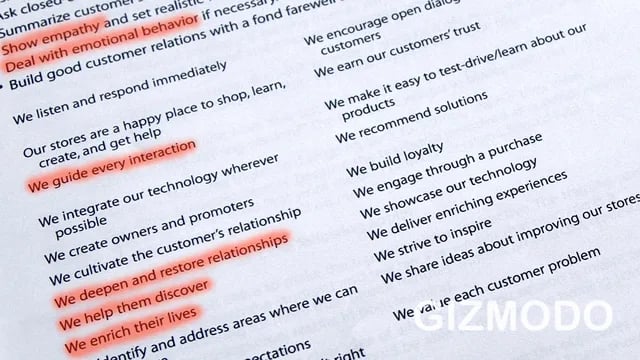How Apple improved their Employee Retention Rate by 28%
TABLE OF CONTENTS
Apple is a company with 510 retail stores and more than 137,000 employees in numerous countries across the world. Keeping such a large number of people happy and loyal may seem an impossible task.
Even more so in a world where voluntary employee turnover has risen year-on-year for the last decade, according to the U.S. Bureau of Labor Statistics.
But against these odds, Apple has managed to ensure that their large global workforce, which includes a dispersed legion of frontline employees at their retail stores, remain engaged and loyal.
Not only did they see an improvement in employee retention rate from 61% to 89% in two years under Senior Vice President of Retail and Online Stores, Angela Ahrendts, but they have consistently ranked in Glassdoor’s Top 100 Companies to Work For. Google and Apple are the only two companies to have ranked every year for the 11+ years the list has been published.
What’s their secret?
1. Unite employees around a strong vision and mission
“We just ended the year with the highest retention rates we’ve ever had – 81%. And the feedback [is that it’s] because they feel connected. They feel like one Apple… The thing I didn’t know before I came in—a month in, I told my husband, ‘I now know why this is one of the most successful companies on the planet: Because the culture is so strong. The pride, the protection, the values.
That foundation, that service mentality, that drive to continue to change lives—that is a core value in the company. And Tim [Cook] then has added this on: He says it’s also our responsibility to leave it better than we found it. So you have these two amazing pillars and a culture built around that. It’s the same in retail and in [Cupertino]. That is the underlying mission.” - Angela Ahrendts
A vision and mission statement unify employees around shared goals and ideals, and instil them with a sense of purpose. Meaning matters - a study found American workers would be willing to trade in 23% of their entire lifetime earnings in exchange for a job that was “always meaningful”.
While a vision is what you want your company to be in the future, a mission is the action you’ll take in the present to steer you towards that future. These are your guiding principles and North Star - they shape the companies’ and individuals’ short and long-term goals.
As your vision and mission are your employees’ reason for getting up in the morning, they need to stay top of mind. It won’t suffice to address them once, during onboarding, then never again - information is only retained when repeated at spaced intervals.
Make sure your vision and mission are powerful, purposeful and clearly communicated. That everyone not only knows what they are but feel fired up about working towards them.

Source: Apple's Genius Training Student Workbook
2. Don’t undervalue any individual and stay in tune with employee sentiment
“I don’t see them as retail employees. I see them as executives in the company who are touching the customers with the products that Jony [Ive] and the team took years to build. Somebody has to deliver it to the customer in a wonderful way.” - Angela Ahrendts
When Ahrendts started at Apple she spent her first 6 months travelling to 40 different markets and meeting employees. This was done in order to find out what was happening on the shop floor and how employees felt about existing processes. In other words, she was keeping a finger on the pulse of the workforce by seeking feedback.
Conducting ‘stay interviews’ (asking employees why they are staying) or why they would leave, is an easy but overlooked method of improving retention. The simple act of reaching out, and empowering people with a voice through sentiment-gathering feedback, makes them 4.6 times more likely to perform at their very best.
Ahrendts also emphasises the importance of prioritizing the engagement of each individual in order to achieve the success of the whole (what we call Workforce Success) regardless of where they are working, or the seniority of their job.
Your people out on the frontlines, interacting with customers, are of no less value than those working behind the scenes, at HQ. If anything, ensuring frontline employees’ experience is optimised is more critical, as they are the public face of your brand, and their level of engagement, motivation and loyalty directly impacts your customers’ experience.
Companies with superior customer experience bring in 5.7 times more revenue than competitors. But to provide superior customer service employees must be engaged - employers that excel at customer experience have employees that are 1.5 times more engaged.
3. Keep people informed
"When I came in, there were a lot of systems that weren't connected, there wasn't a way to communicate." - Angela Ahrendts on RBC’s Disruptors podcast
Free-flowing of information is critical to any organization’s success. It doesn’t matter if you have 137,000 employees, or 10. If communication is poor - from micro-communication between teams and macro-communication across the company - people will begin to feel distanced from your mission, and lose their daily sense of purpose.
Under Ahrendts, Apple introduced new channels of communication, for retail employees to receive information and actively communicate between each other. The first of these was its “Hello” app. The “Hello” app delivers a succinct summary of an employees’ need-to-know information daily.
The second of these, the “Loop” app, opens streams of communication between employees themselves. Through Loop, staff engage in peer-to-peer learning of sorts by exchanging best practice tips and tricks with each other, helping one and another perform their jobs more successfully.
4. Choose the right employees to begin with
Part of mitigating churn, other than listening to people, having a strong vision and mission, and keeping everyone in the loop, is hiring the right person for the role in the first instance.
Some employees are destined for disengagement and, eventually, churn. These are people who may never have been all that excited to start with your organization to begin with. Don’t fret over these losses - actively disengaged employees will do more damage to your company if they stay.
The key is to weed the unenthused out from the evangelists early on, in the hiring process. Apple put greater emphasis on team and cultural fit, and alignment with vision and mission of potential new hires than on other attributes.
Ron Johnson, a former Vice President at Apple, once boasted that it was “harder to land a job at an Apple Store than to get into Stanford”, where he studied. It is said that if an applicant is late to the first stage of Apple’s hiring process - a seminar - their application is automatically rejected.
Whatever Apple’s policies, the takeaway is to make as informed a hiring decision as you can.
5. Continually train and develop employees
As one New York Times article put it, if Apple are hiring “devotees” to begin with, their onboarding process and subsequent employee training turns them into “disciples”.
In 2012, Gizmodo leaked Apple’s Genuis Training Student Workbook. It’s an extensive, multi-paged onboarding guide for new hires that covers everything from Apple’s values, to how to give and receive feedback, to roleplaying scenarios, to how to be empathetic and how to read customers’ body language. It is complemented with a 14 day bootcamp.
Apple’s emphasis on the power of empathy is noteworthy - empathy is something integral to not just employee-customer relationships, but to employer-employee relationships. The significance of empathy is highlighted by the following two statistics - 9 in 10 employees would stay with an empathetic employer, and 6 in 10 would take a pay cut if it meant their employer would be more empathetic.
Communication is critical, but it’s knowledge that empowers. Engaging your people with relevant learning material that they receive at their point of need will supercharge their performance. It's ongoing, timely learning that is at the crux of building long lasting loyalty between employer and employee, i.e. turning your “devotees” into “disciples”.
Want to see how you can use eduMe to inspire loyalty and reduce churn, by delivering impactful training and information that engages your employees, contractors, clients or freelancers, no matter where or how they work?
Join 10,000+ frontline leaders
Subscribe to ‘Training the Frontline’ and get weekly insights sent straight to your inbox.

